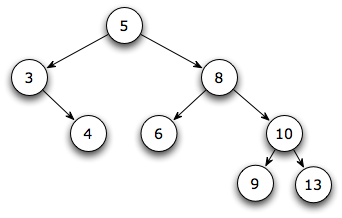CSSE 230
Data Structures and Algorithm Analysis
Homework 7 - 62 points
To Be Turned In
Submit #1 to the drop box.
- (If doing EditorTrees with a partner) Don’t forget: You should be
keeping an individual log about your team project work so that you can
write a performance evaluation for each of your teammates. You do not
need to turn in this log, but I wanted to remind you while I had your
attention.
- (15 points) In this problem you will check your understanding of collision resolution techniques in hash tables.
Given the input
{4371,1323,6173,4199,4344,9679,1989}, a fixed table size of 10,
and a hash function H(X) =Xmod 10, insert the values in order and show the resulting final...
- Linear probing hash table
- Quadratic probing hash table
- Separate chaining hash table
- (47 points + up to 5 BONUS points) StringHashSet
implementation. Check out the project from your Github classroom using this link. You will be
implementing a HashSet using separate chaining. It implements many of the methods from Java's Set
interface. Additionally:
- You will use an array for internal storage, and will grow the array when lambda gets too big. (Don't use an ArrayList since it won't grow at the right time.)
- It only needs to work for Strings.
- You will implement a method to compute the String hash
code.
- You will also implement a toRawString function that
dumps out the
array of LinkedLists without formatting - this is to make sure it is
putting everything in the right place.
- You will implement many other methods. I did them in
the
order they appeared in the file, and the tests for later ones assume
you passed the tests for the earlier ones. For example, to test
remove(),
we need to be able to add values first.
- One cannot insert null
- Java's
HashSet has an initial capacity of 16 and rehashes when lambda reaches
.75. To force more collisions earlier, we will use an initial
capacity
of 5, and rehash when lambda reaches 2.
- The
most challenging (fun) part of this was writing an iterator, since it
needed to traverse a bunch of possibly empty linked lists. Once you
have an iterator, it made some other things (toString and rehashing)
easier. But I recognize you are busy with your project, so am making
the iterator optional, and worth a few bonus points as a reward if you
get
it working on your own.
- Make progress on the Heaps and Heapsort assignment during class.
(If you choose to use class time differently, you should plan to spend some out-of-class time on it.)
This will be part of a later assignment.
Optional practice problem - not to be turned in.
This problem has been assigned in the past. Since you are actually implementing
height-balanced trees, it seems redundant. But it could still be a very
good practice problem for the next exam, so I did not remove it.
(0 points) Start with the following Binary Search Tree:

See the hint at the end!
- Is this an AVL tree? ____ If not, rearrange it so that it
is height-balanced.
- Draw the tree after insertion of a node containing 11,
using the usual BST insertion algorithm.
- Is the new tree AVL? ______ If not, name the node where
the rotation should be done, according to the algorithm from class.
______ Single or double rotation? ____________ If you need to do a
rotation, draw the resulting tree.
- Delete the element 5 from the original
tree (not the one from part c), using the BST deletion algorithm described
in class and in the textbook. Draw the new tree.
- Is the new tree AVL? ______ If not, name the node where
the rotation should be done, according to the algorithm from class.
______ Single or double rotation? ____________ If you need to do a
rotation, draw the resulting tree.
- Is your new tree (if any) AVL? ______ If not, name the
node where the rotation should be done, according to the algorithm from
class. ______ Single or double rotation? ____________ If you need to do
a rotation, draw the resulting tree.
- Add the element 5 to the tree from part (f) using the BST
algorithm. Draw the new tree.
- Is the new tree AVL? ______ If not, name the node where
the rotation should be done, according to the algorithm from class.
______ Single or double rotation? ____________ If you need to do a
rotation, draw the resulting tree.
- Add the element 12 to the tree from part (h). Draw the new
tree.
- Is the new tree AVL? ______ If not, name the node where
the rotation should be done, according to the algorithm from class.
______ Single or double rotation? ____________ If you need to do a
rotation, draw the resulting tree.
- Add the element 7 to the tree from part (j). Draw the new
tree.
- Is the new tree AVL? ______ If not, name the node where
the rotation should be done, according to the algorithm from class.
______ Single or double rotation? ____________ If you need to do a
rotation, draw the resulting tree.
Hint: In my solution, for all
the sub-parts together, I did three single rotations and no double
rotations. The first four leaf nodes in my final tree were 3, 5, 7, and
9. (In my first attempt, I misread
part d) and deleted from the tree in part c) rather than the original
tree. With that mistake, for all the sub-parts together, I did two
single rotations and one double rotation and the first four leaf nodes
in my final tree were also 3, 5, 7, and 9.)
